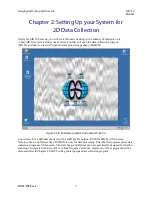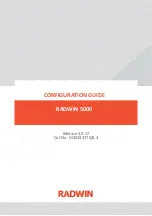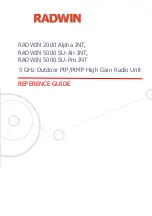
Geophysical Survey Systems, Inc.
SIR® 20
Manual
MN92-078 Rev F
20
Gain
The second button controls the Time-Variable-Gain (TVG). Gain is signal amplification used to
compensate for the natural effects of signal attenuation. As the transmitted signal passes through a
material, it will weaken (attenuate) as the material absorbs some signal. Gain amplifies that signal after it
is received to compensate for signal losses and make weaker reflectors easier to see. No additional energy
is sent out of the antenna.
The Gain function operates at a number of linearly distributed points along the time range. The Auto Gain
Servo automatically sets the gain of the system based upon the received signal from the antenna
at the
point where the antenna is located when the servo is enabled
. At large sites it may be necessary to briefly
scan the site to decide if the Auto Gain Servo gain values are too high or too low.
In either case, you should adjust the gains manually. You cannot set the exact time of a gain point;
however, you can manipulate the number of gain points so as to ‘position’ a gain point near a particular
time range (or a particular reflector). You can then adjust the amount of gain applied.
Gain should never decrease with depth. Each successive gain point should be greater than or equal to the
previous. Be careful not to apply too much gain. This will lead to a phenomenon known as ‘clipping’.
Clipping will limit the data and will cause you to lose valuable information and make it much more
difficult to identify targets in the data. In addition, RADAN functions such as vertical and horizontal
filtering, FFT filtering, Spectrum transformation and Hilbert envelope processing will not operate
correctly on the data. If you prefer to leave the gain setting up to the SIR 20, make sure that Auto Gain
Servo is enabled.
Figure 17: Example of clipped versus acceptable data.
Filters and Stacking
The next three buttons control filters and stacking. These are useful for removing both high and low
frequency noises, as well as horizontal noise known as ‘ring-down’ in the data. Horizontal noise is an
artifact caused by variability in antenna coupling or high surface permittivity/ conductivity. A background
removal filter of suitable length will remove these artifacts.
Many of the filter parameters are antenna-specific and are set automatically for the antenna that you chose
in Step
6
. If you are using an antenna other than one listed in the default configuration you should alter
the filter settings for the antenna being used. Consult your antenna documentation for correct settings.
GSSI recommends that inexperienced users accept the default settings.
Содержание SIR 20
Страница 1: ......
Страница 4: ......
Страница 6: ......
Страница 12: ...Geophysical Survey Systems Inc SIR 20 Manual MN92 078 Rev F 6 ...
Страница 56: ...Geophysical Survey Systems Inc SIR 20 Manual MN92 078 Rev F 50 ...
Страница 67: ...Geophysical Survey Systems Inc SIR 20 Manual MN92 078 Rev F 61 Figure 65 Migration Comparisons ...
Страница 88: ...Geophysical Survey Systems Inc SIR 20 Manual MN92 078 Rev F 82 ...
Страница 96: ...Geophysical Survey Systems Inc SIR 20 Manual MN92 078 Rev F 90 ...
















































